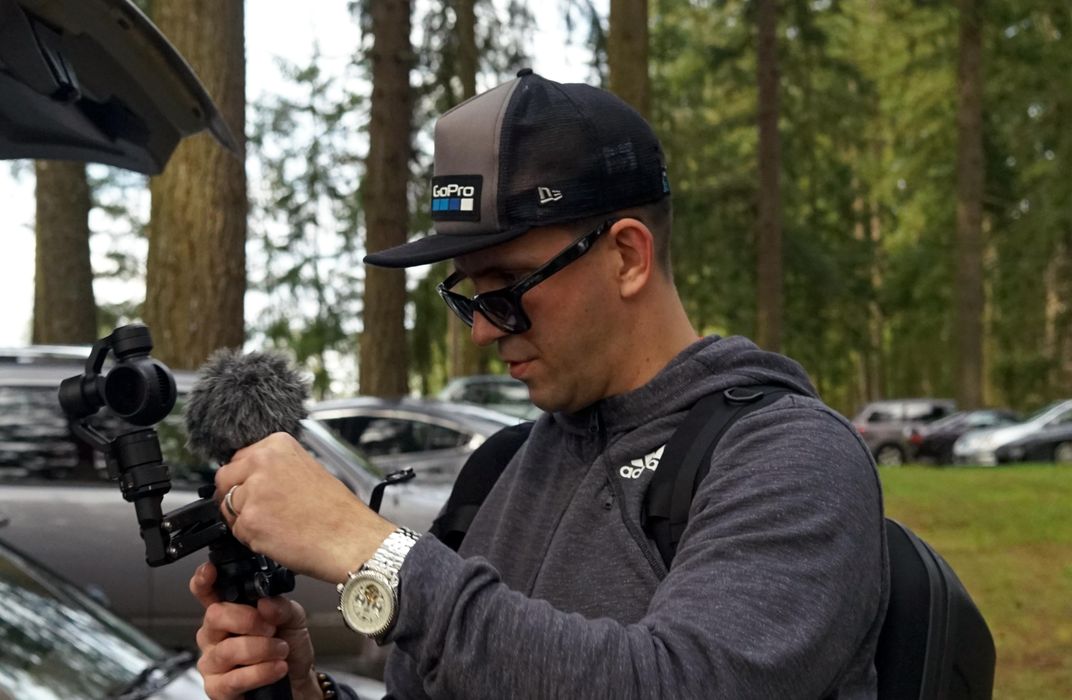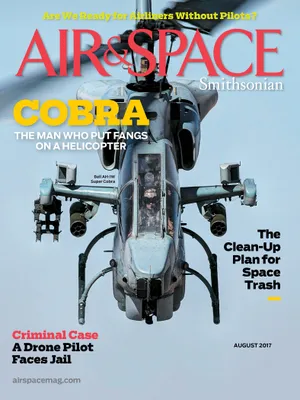If You Crash a Drone, You Might Land Yourself in Jail
The story behind a recent landmark conviction.
:focal(906x2885:907x2886)/https://tf-cmsv2-smithsonianmag-media.s3.amazonaws.com/filer/51/03/510375ea-35a3-4c03-822d-e7afdd2a7b52/36a_aug2017_option1dji_live.jpg)
On January 13, 2017, Paul Skinner earned a place in aviation history he doesn’t want: The 39-year-old became the first drone pilot convicted of a crime for the manner in which he flew. Others have been jailed for flying drones because they were using them to commit crimes; some are serving prison sentences, for example, for remotely piloting aircraft to smuggle drugs and other contraband into prisons. But Skinner’s conviction was unique: When he lost control of his DJI Phantom 3 quadcopter during a parade and two people were injured, he was charged and convicted of reckless endangerment, a misdemeanor.
Skinner’s story begins around noon on June 28, 2015. Seattle’s annual Gay Pride parade was about to get under way amid the skyscrapers that line downtown Fourth Avenue. The street was filled with parade floats and people.
The video from Skinner’s drone begins with the aircraft on the ground where Fourth meets Marion Street. The broad white stripes of the crosswalk loom large across the bottom of the frame. As the Phantom lifts off and turns, a woman with shocks of purple hair enters the frame holding a small child, and both look at the rising camera.
The drone is quickly above them and moving north along the avenue, flying through the canyon of high-rise buildings with crowds of parade-goers below. Moving up the street, the quadcopter drifts to the right but then crabs slightly to the left, as if fighting a crosswind.
The Phantom approaches the end of the block, and the triangular wedges of glass and steel forming the exterior of Seattle’s Central Library seem startlingly close. The library’s roof is 185 feet high; the drone is high enough to film it. As the drone turns, slices of Puget Sound flash past between skyscrapers. When the image stabilizes, the aircraft is again facing the library, but retreating. The video suddenly ends at 55 seconds into the flight. One second later the Phantom 3 crashed into the 50-story office building at Safeco Plaza.
Although the Phantom was no longer recording, surveillance cameras at Safeco Plaza captured what happened next. One camera is mounted on the front of the Safeco skyscraper and looks down on the plaza several stories below. Small knots of people are milling around, waiting to join the parade. A barely visible white blur plummets from above and strikes a man standing with a small group of people near the base of the building. The blur ricochets off the man’s head and into a woman’s forehead. The man can be seen rubbing his head in the seconds after impact. The woman is doubled over, her hands covering her face as a companion offers aid. When she looks at her hands, they are covered in blood, according to court records. Unsteady on her feet, she is helped to a nearby bench.
A few minutes later the surveillance camera reveals a man, identified in court as Skinner, walking amid the crowd in the middle of the street with a drone controller in his hand. Apparently spotting the fallen drone, Skinner turns off the street and breaks into a trot to approach a man holding the fallen quadcopter.
The aircraft has fallen among a group of lawyers. Although the surveillance camera did not capture sound, one of the lawyers later testified that Skinner claimed ownership of the aircraft and demanded its return. When the lawyers refused, a brief tug of war erupted, with both sides pulling on the drone. Skinner gave up the fight and left the area. The injured woman later testified that an ambulance took her to a hospital, where she was treated for the cut on her forehead (doctors later determine she suffered a concussion as well). Surprisingly, the man who was first struck suffered only a small bump on the head and marched in the parade as planned.
Skinner remained unidentified until he and his father, a lawyer in nearby Oak Harbor, called Seattle police to claim the drone and request that the injured woman contact them so they could begin addressing her medical bills. Paul Skinner met with a detective a few weeks later and authorized police to search the drone’s memory card for video and GPS data, which were later introduced in court as evidence.
**********
Section 333 exemptions, named for the statute authorizing them, are the legal mechanism by which the Federal Aviation Administration allows drones to fly for commercial gain. The exemptions establish a number of strict requirements and flight restrictions, including that all pilots flying under the exemption hold a pilot license issued by the FAA. (The rules for hobbyists are more lenient.) Both professionals and hobbyists are prohibited from flying over crowds. Skinner filed for his exemption on April 6, 2015, and it was granted on August 5—roughly a month after the Seattle accident. The exemption authorizes only a specific drone, a DJI Phantom 2 Vision+, not the Phantom 3 he flew over the Pride parade.
Seattle had seen other drone-related incidents, but since no injuries were involved, prosecutors declined to file charges. This was different. “[Skinner] was clearly a danger to the citizens of Seattle based on his actions,” says Assistant City Attorney Raymond Lee, who led the prosecution for the City of Seattle. “This wasn’t a minor indiscretion. This is him well aware of all the issues and basically ignoring it, saying it doesn’t apply to him.”
Skinner is no hobbyist, and the drone he flew that day was his livelihood: He is listed as the founder and senior pilot of Vivid Aerial Ascent, an aerial footage company, and letters to the court from clients—including the Oak Harbor Chamber of Commerce and the PBY-Naval Air Museum—testify to his professionalism and character. The Vivid Aerial Ascent website also shows other drones overflying people, and Lee confirms that this imagery was a factor in the decision to prosecute Skinner.
The Seattle prosecutor’s office does not have authority to revoke a Section 333 exemption. Only the FAA can undertake that action. (The FAA declined to comment on Skinner’s case, but Lee says the agency is investigating.) Currently, the FAA has 48 drone-related enforcement actions under way across the country, but these are not criminal prosecutions like the Skinner case. Aviation attorney Jonathan Rupprecht, who represents drone pilots before the agency, says there is a growing nationwide trend for local authorities to file reckless endangerment charges even when no injuries or damages occur, though no other convictions have resulted. “The big issue when it comes to these charges is how likely is great bodily harm or death to happen? Officers will arrest when there is a really small chance, and the prosecutors will be like ‘Yes, but was there a substantial amount of risk?’ ”

Skinner was particularly unlucky: His case came on the heels of two very public local drone incidents. In the first, a small drone crashed into the Ferris wheel on Seattle’s waterfront, but no one was hurt, and damage was slight. The city prosecutor decided against charging anyone. Just days before Skinner went to trial, a DJI Inspire crashed at the feet of pyrotechnicians working on the roof of the Space Needle as they prepared for a New Year’s fireworks display. It wasn’t the first drone incident involving the iconic landmark—the Space Needle’s management publicly jokes that it is virtually a drone “tractor beam”—but this incident was so egregious and public that city prosecutors felt the need to make a point. And Skinner’s upcoming trial became the opportunity to make it.
Skinner’s lawyer, Jeffrey Kradel, argued that the city had no proof Skinner knew what he was doing, so his actions didn’t rise to the standard of reckless endangerment. To be found guilty, Skinner would have to have known that the flight was risky and acted in spite of that knowledge. In response, Lee pointed to Skinner’s membership in the Academy of Model Aeronautics and the various safety warnings in manuals and documents, including Skinner’s Section 333 exemption application, all of which warn pilots of uncrewed aerial vehicles never to fly over people. Kradel finally argued that even if Skinner had the safety information, the city had no proof that he read it.
The trial lasted four days, and it took only a few hours for the jury to return with a guilty verdict.
During the February 24, 2017 sentencing hearing, Lee told the court that while Skinner didn’t intend to injure anyone, “Mr. Skinner’s intentional act is that he did bring a drone into the downtown area, he intentionally flew the drone over a large crowd of people, he intentionally did so near near tall buildings and he intentionally did so outside his direct line of sight,” violating well-known safety standards. Citing Skinner’s Section 333 exemption, Lee said “the defendant is not a 17-year-old boy who was given a drone as a Christmas present. The defendant is a part of a company who provides aerial photography as a drone service. So, more than anyone else, he should be well aware of the potential dangers of a drone.”
Lee added that “one of the things that is clear from reviewing the defendant’s criminal history is that he doesn’t make very good decisions.” (Skinner’s record includes convictions in 2008 for theft, assault, and drug possession. Following a firearms charge in 2011, he went to prison for 41 months.) “And in this case, he made an extremely poor one. And to this point, I’ve not heard an acknowledgment of that poor decision. The citizens of Seattle should not [have to] fear a drone falling on them from the sky.”
Addressing Judge Willie Gregory before he passed sentence, Skinner said: “I respect the jury’s verdict. I understand the implications of the poor judgment of putting [the drone] up in a crowded area.” He concluded: “I’ve put my history in my rear-view mirror, and Your Honor, I just respect and accept any sentence you impose.”

Judge Gregory sentenced Skinner to a year in jail and fined him $5,000, the maximum sentence allowed by the legal statute. He also ordered Skinner to register all of his drones with the FAA, to attend a UAV safety class, and to strictly comply with his Section 333 exemption. But then Gregory suspended all but 30 days of the jail time and $500 of the fine—as long as Skinner obeys the rules for the next two years. If, during that time, he should again be found out of compliance with his Section 333 exemption, or with the terms of his sentence, he could be sent to jail for the full term and be made to pay the full fine.
Skinner’s legal team offered a deal to the city. In a motion submitted to the court, Skinner promised not to appeal his conviction in exchange for 90 days of home confinement. Judge Gregory refused to consider the motion.
Skinner wrote in a statement to Air & Space that he believes the punishment doesn’t fit the crime, and that prosecutor Lee went out of his way to ask for a harsher-than-required sentence. “This is, simply put, fear-mongering, manipulation of the public through sensationalized and inaccurate reporting by local and national media outlets, and a politically agenda driven case.
“While I recognize the decision to attempt a UAV flight, of any altitude, in close proximity of a crowd may have been poor judgement, I do not believe that a 30 day jail sentence fits the guilty verdict rendered by the ‘jury of my peers,’ ” Skinner writes.
As this issue went to press, Skinner remained free on bond as his lawyers worked on his appeal. But Judge Gregory, citing public safety, insisted Skinner meet the terms of his sentence regarding drone registration, the safety class, and his Section 333 exemption requirements in the meanwhile.
In a video posted to Facebook dated December 1, 2016, just weeks before his trial, Skinner flies a quadcopter while the Sumner High School senior class spells out “2017” on the school’s football field. In the unedited video, Skinner repeatedly flies over the students and even makes low, swooping passes overhead. Toward the end of the video, the flight controller can be heard beeping while a prerecorded voice declares “low battery.” With the controller continually beeping, Skinner sends the aircraft from near ground level to high above the assembled students for more photos. As he hovers at altitude, the controller issues a critical battery warning. It’s a last-ditch measure on the part of the aircraft system, and results in an automatic landing so the aircraft doesn’t fall out of the sky because of a dead battery. Skinner can be heard saying “Here it comes. It’s coming down by itself.” As the aircraft descends, he can be heard jokingly saying: “I know what I’m doing.”
